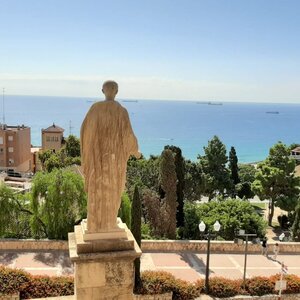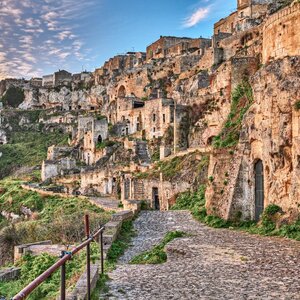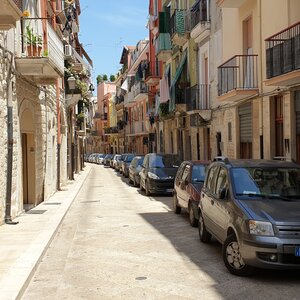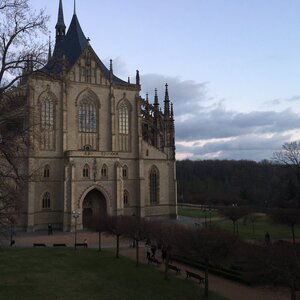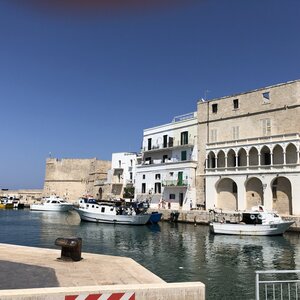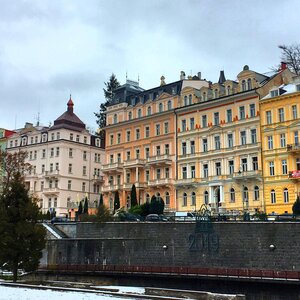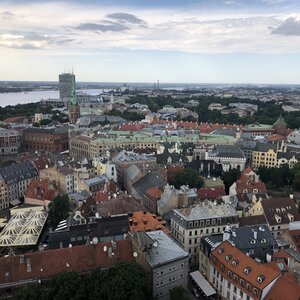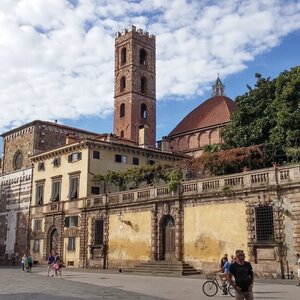In one day you can see three historical towns of the «Danube River Basin» — Esztergom, Visegrád and Szentendre. One more day is needed to visit the «Hungarian Sea» — Lake Balaton and the birthplace of the famous red wine «Bull’s Blood» — the city of Eger and its surroundings.
Esztergom (Esztergom)
50 km from Budapest, on the border with Slovakia, is the small ancient Hungarian town of Esztergom. It is the birthplace of Hungary’s first and most revered King Istvan. In X — XIII centuries Esztergom was the capital of Hungary, and after that it survived several invasions. At different times it was seriously damaged by the Mongols, Czechs and Turks.
Currently, Esztergom is home to less than 30,000 inhabitants. The city remains today the religious capital of Hungary, and its main attraction is the largest and most important church in Hungary — the Basilica of St. Adalbert.
St. Adalbert’s Basilica (Nagyboldogogasszony és Szent Adalbert Prímási Főszékesegyház),
The Basilica of St. Adalbert was built in 1869, but the first church on this site dates back to the beginning of the 11th century. The current building of this church is the seventh on the fortress mountain. The height of the modern Basilica of St. Adalbert is 100 meters, the main dome is 71.5 meters high and 33.5 meters in diameter.
The Basilica’s treasury, panoramic hall, dome and crypt are open to the public and can only be reached by a spiral staircase. Inside the temple is decorated with frescoes, mosaics and statues. The columns and walls are decorated with different types of marble.


The Royal Palace of the Arpad dynasty.
TheMagyar Nemzeti Múzeum is housed in the palace building next to the Basilica. The palace was built in Romanesque style in the 10th century and restored after its complete destruction in the 1930s. Medieval knights' armor and weapons, household items, tapestries, paintings and sculptures are exhibited here.
Mária Valéria Bridge (Mária Valéria híd)
This half-kilometer bridge over the Danube is named after the daughter of Hungarian Emperor Franz Joseph. It connects Hungary with Slovakia near the town of Štúrovo. The bridge was opened in 1895, but 50 years later it was blown up by the Nazis. The crossing was restored only in 2001.
Archbishop’s Palace
Neoclassical building from the late 19th century. The palace now houses a museum of Christianity(Kereszteny Muzeum), where you can see works on religious themes by Hungarian and European medieval masters.
How to get to Esztergom:
- Volánbusz buses. From ÁRPÁD HÍD AUTÓBUSZ bus station, route No. 800: travel time 1 hour and 15 minutes, fare 840 HUF and route No. 801: travel time 2 hours, fare 1300 HUF.
- By train MÁV. From Budapest-Nyugati West Railway Station, travel time is 1 hour 10 minutes, fare is 1120 HUF.

Visegrád (Visegrád)
Visegrád is a small town 45 km from Budapest, with a population of less than 1800.
The main attraction is the Visegrad Fortress, built in the early 11th century. The fortress is located on a high hill, it was destroyed and rebuilt several times, the last restoration began in the XX century. There are more than 300 halls in the fortress, only a part of them has been restored. There is a wax museum with the interior and figures of people in XIII century clothes.
Solomon’s Tower is the only element of the Visegrad Castle that has survived to this day, where famous prisoners were imprisoned, and legend has it that Vlad Tepes, the prototype of Count Dracula, was held here.
The second attraction of Visegrád is the ruins of the royal palace, which served as the summer residence of Hungarian monarchs in the XIV–XVI centuries. The palace has been partially restored and details of medieval life can be seen here.
How to get to Visegrad:
- Busroute #880: travel time is 1 hour and 20 minutes, fare is 745 HUF.



Szentendre
20 km from Budapest is the Hungarian city of artists — Szentendre, founded by Serbs in the XVII century. There are many art galleries and museums, craft and souvenir shops, Catholic and Orthodox churches.
Szentendre is an atmospheric town with cobbled streets, red tiled roofs of houses and colorful varied facades.
There are more than 10 museums in the city. I will tell you about the most interesting of them.
Marzipan Museum (Szabó-Szamos Marzipan Museum)
Marzipan is a mixture of ground almonds and powdered sugar. It is similar in consistency to plasticine and is used to make edible figures and decorate cakes.
The museum has exhibits made of marzipan: life-size famous personalities, miniatures from fairy tales, Hungarian landmarks and much more. On the first floor there is a store selling marzipan and sweets made of marzipan.


Ceramics Museum (Kovács Margit Kerámiamúzeum)
The Ceramics Museum was opened in 1973 and features works by the famous sculptor Margit Kovacs, housed in 11 rooms.
Ethnographic Museum (Szentendrei Szabadtéri Néprajzi Múzeum)
It is an open-air museum with about 400 Hungarian peasant buildings from the 18th and 19th centuries as exhibits — it is a relatively large village. The houses can be viewed from the outside and inside.
How to get to Szentendre:
- By suburban train route H5, from Batthyány tér metro station, 40 minutes, fare 660 HUF.
- By bus from the bus station at Újpest-Városkapu metro station. Travel time is 30 minutes and the fare is 310 HUF.
- As part of a half-day group excursion in Russian with transfer from Budapest from the hotel and back, for 39 €.
Esztergom, Szentendre and Vysehrad can be visited in one day as part of a group tour from Budapest for 56 € — the tour lasts 8.5 hours.

Eger
Eger is a town of winemaking and thermal springs, located in a mountain valley at a distance of 130 km from Budapest.
Eger Fortress (Egri Vár)
The main attraction of the city is the Eger Fortress(Egri Vár), which began to be built in the 12th century. The citadel houses the István Dobó Museum, which tells the history of the fortress, an art gallery, a mint and a wax museum.
Turkish minaret (Egri minaret)
A building from Ottoman times, from which you have a view of the entire Yeager. You can climb up a very narrow staircase with 93 steps.
Valley of Beauties (Szépasszony — Völgy)
The Valley of Beauties is a small park on the outskirts of the city, where about 200 wine cellars are located. Here you can taste and buy the local famous red wine — Eger Bull’s Blood (Egri Bikaver).
According to legend, when the Turks besieged the Eger fortress in the 16th century, the commandant Istvan Dabo ordered the defenders of the fortress to drink red wine to strengthen their spirits. The Turkish warriors, seeing the Hungarians' surge of strength, thought they were drinking ox blood.
«Eger Bull’s Blood» is a registered and legally protected name. Wine under this brand can only be produced in Eger. In mid-summer, the city hosts a festival of the drink, where you can taste different versions of «Bull’s Blood» from local winemakers.
Egerszalok Thermal Spa (Egerszalok)
It is located 6 km from Eger in a small village. The main attraction is a salt hill and a healing sulphur spring with hot water (65 degrees Celsius). The hotel Saliris Resort Egerszalók with SPA complex, which can be visited for a fee, is built near them.
How to get to Eger:
- By train from Keleti station (Budapest-Keleti). Travel time 2 — 2.5 hours, fare from 2520 HUF.
- By bus route #1050, the fare is 2520 HUF, traveling 1 hour and 40 minutes.
Balatonfüred (Balatonfüred)
Balatonfüred is one of the spa towns located on the northern coast of the famous Hungarian Lake Balaton. The distance to Budapest is 130 km. Balaton is called the «Hungarian Sea», and it is famous all over the world for its healing waters. You can swim in the lake at one of the three paid beaches in the city.
Balatonfüred was founded at the end of the XVIII century, nowadays it is home to about 13 thousand people. The historical part of the town is made up of old mansions built for Austrian and Hungarian aristocracy in Baroque and classical style. Hotels are open in most of them.
The most famous houses:
- Horváth ház (Horváth family house): Built in the 18th century in the late Baroque style. It is famous for the fact that for almost 100 years, on the last Saturday in July, the Anna’s Ball, a major social event in Hungary, has been held here.
- Villa Blaha Lujza (Villa Blaha Lujza), the most famous Hungarian opera singer. Built in the 19th century, it is now a hotel.
- The house-museum of the famous Hungarian writer Jókai Mór (Jókai Mór Emlékház) with recreated 19th century interiors.
In the center on Gyógy tér (Gyógy Square), a drinking cistern with therapeutic water has been functioning since 1800. There is a cardiology clinic in the city, where local water rich in calcium and magnesium is used for treatment.
In the vicinity of Balatonfüred you can visit:
- Annagora Aquapark with thermal water for adults and children with slides, saunas and pools.
- Lóczy cave(Lóczy barlang) is 120 meters long and has a healing microclimate.
- Pribalaton Uplands National Park(Balaton-felvidéki Nemzeti Park). The park with volcanic landscape covers an area of 570 square kilometers. It is home to rare animals and birds, extinct volcanoes and geysers, lakes and caves.
How to get to Balatonfüred:
- By bus, routes No. 1190 and No. 1201. Travel time is 2 hours and the fare is 2725 HUF.
- By train from Kőbánya-Kispest or Budapest-Déli stations, there are more than 20 trains to Balatonfüred every day. Depending on the train, the travel time will be 2 to 3 hours and the fare from 2520 HUF to 2830 HUF.
A trip to Balaton will take approximately a whole day, so it is worth considering a group tour: a 10-hour trip with a Russian-speaking guide and hotel transfer will cost 190 € per person.
Useful information:
- Hungary is a member of the European Union, but the official currency in the country is not the Euro, but Hungarian forints (HUF). Approximate exchange rate: 100 HUF = 20 rubles.
- The Hungarian language (Magyar) belongs to the Finno-Ugric group and is absolutely incomprehensible for the Russian and European tourist.
- English is spoken in Hungary mainly in tourist areas and hotels. Therefore, I recommend that you write down the necessary names and addresses in Hungarian, so that if necessary you can explain yourself to the locals in sign language by showing the names in Hungarian.
- Rent a car in Budapest: Rentalcars — from 20 € per day.
- Search and buy bus tickets — Autobus.travel.


